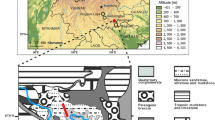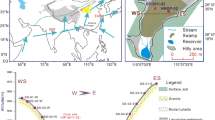Abstract
Lake Lop Nur is located in the eastern part of the Tarim Basin in Xinjiang, northwestern China. A 220-cm-long sediment core was collected from the center of the ear-shaped depression forming the basin and dated with AMS14C. Grain size, total organic matter (TOC), total nitrogen (TN), and TOC/TN (C/N) analyses were used to reconstruct climatic conditions from 13.0 to 5.6 cal ka BP. The results showed five main climatic stages. Zone I (13.0–11.3 cal ka BP) was a wet–dry environment, whereas Zone II (11.3–8.9 cal ka BP) consisted of a primarily wet environment. Zone III (8.9–7.7 cal ka BP) was subdivided into Zone IIIa (8.9–8.2 cal ka BP) that indicated lake constriction and dry climate, and Zone IIIb (8.2–7.7 cal ka BP) in which the proxies indicated wet conditions. In Zone IV (7.7–6.6 cal ka BP), the climate presented a bit wet conditions. In Zone V (6.6–5.6 cal ka BP), abundant glauberite is present in the sediment and silt dominates the lithology; these results indicate the lake shrank and the overall climate was dry. Abrupt environmental events were also identified, including six dry events at 11.0, 10.5, 9.3, 8.6, 8.2, and 7.6 cal ka BP and one flood event from 7.8 to 7.7 cal ka BP in the Early–Middle Holocene.
Similar content being viewed by others
References
Alley R B, Ágústsdóttir A M. 2005. The 8ka event: cause and consequences of a major Holocene abrupt climate. Quaternary Science Review, 24 (10-11):1123–1149.
Alley R B, Mayewski P A, Sowers T, Stuiver M, Taylor K C, Clark P U. 1997. Holocene climatic instability: a prominent, widespread event 8200 yr ago. Geology, 25 (6): 483–486.
Alley R B. 2000. The Younger Dryas cold interval as viewed from central Greenland. Quaternary Science Reviews, 19 (1-5): 213–226.
Alve E, Lepland A, Magnusson J, Backer-Owe K. 2009. Monitoring strategies for re-establishment of ecological reference conditions: possibilities and limitations. M arine P ollution B ulletin, 59 (8-12): 297–310.
Battarbee R W. 1999. The importance of palaeolimnology to lake restoration. Hydrobiologia, 395: 149–159.
Blaauw M, Christen J A. 2011. Flexible paleoclimate agedepth models using an autoregressive gamma process. Bayesian Analysis, 6 (3): 457–474.
Bond G, Showers W, Cheseby M, Lotti R, Almasi P, de Menocal P, Priore P, Cullen H, Hajdas I, Bonani G. 1997. A pervasive millennial-scale cycle in North Atlantic Holocene and glacial climates. Science, 278(5341):1257–1266.
Broecker W S, Bond G, Klas M, Bonani G, Wolfli W. 1990. A salt oscillator in the glacial Atlantic? 1. The concept. Paleoceanography, 5 (4): 469–477.
Cai B G, Edwards R L, Cheng H, Tan M, Wang X, Liu T S. 2008. A dry episode during the Younger Dryas and centennial-scale weak monsoon events during the early Holocene: a high-resolution stalagmite record from southeast of the Loess Plateau, China. Geophys ical Res earch Let ters, 35 (2): L02705.
Chen G Q, Yi L, Chen S L, Huang H J, Liu Y X, Xu Y H, Cao J R. 2013. Partitioning of grain-size components of estuarine sediments and implications for sediment transport in southwestern Laizhou Bay, China. Chinese Journal of Oceanology and Limnology, 31 (4): 895–906.
Denton G H, Hendy C H. 1994. Younger Dryas age advance of Franz Josef glacier in the southern alps of New Zealand. Science, 264(5164):1434–1437.
Dong Z B, Lv P, Qian G Q, Xia X C, Zhao Y J, Mu G J. 2012. Research progress in China’s Lop Nur. Earth -Science Reviews, 111 (1-2): 142–153.
Dykoski C A, Edwards R L, Cheng H, Yuan D X, Cai Y J, Zhang M L, Lin Y S, Qing J M, An Z S, Revenaugh J. 2005. A high-resolution, absolute-dated Holocene and deglacial Asian monsoon record from Dongge Cave, China. Earth and Planetary Science Letters, 233 (1-2): 71–86.
Garcin Y, Vincens A, Williamson D, Buchet G, Guiot J. 2007. Abrupt resumption of the African Monsoon at the Younger Dryas—Holocene climatic transition. Quaternary Science Reviews, 26 (5-6): 690–704.
Håkanson L, Jansson M. 1983. Principles of Lake Sedimentology. Springer, Berlin. 316p.
Han S T, Li Z Z. 1994. The accumulating regulation of deposit geochemistry of Balikun Lake, Xinjiang.
Oceanologia E t Limnologia Sinica, 25 (4): 429–437. (in Chinese with English abstract)
Jia H J, Qin X G, Liu J Q. 2012. Environmental changes recorded by major elements in Loulan Stupa Section during Early–Middle Holocene. Journal of Earth Science, 23 (2): 155–160.
Keigwin L D, Lehman S J. 1994. Deep circulation change linked to Heinrich event 1 and Younger Dryas in a middepth North Atlantic core. Paleoceanography, 9 (2): 185–194.
Klitgaard-Kristensen D, Sejrup H P, Haflidason H, Johnsen S, Spurk M. 1998. A regional 8200 cal. yr BP cooling event in northwest Europe, induced by final stages of the Laurentide ice-sheet deglaciation? Journal of Quaternary Science, 13 (2): 165–169.
Kranck K, Smith P C, Milligan T G. 1996a. Grain-size characteristics of fine-grained unflocculated sediments I: ‘one round’ distributions. Sedimentology, 43 (3): 589–596.
Kranck K, Smith P C, Milligan T G. 1996b. Grain-size characteristics of fine-grained unflocculated sediments II: ‘multi-round’ distributions. Sedimentology, 43 (3): 597–606.
Lerman A. 1978. Lake: Chemistry, Geology, Physics. Springer-Verlag, Berlin. p.79–83.
Li X Q, Zhao K L, Dodson J, Zhou X Y. 2011. Moisture dynamics in central Asia for the last 15 kyr: new evidence from Yili Valley, Xinjiang, NW China. Quaternary Science Reviews, 30 (23-24):3457–3466.
Liu X Q, Herzschuh U, Shen J, Jiang Q F, Xiao X Y. 2008. Holocene environmental and climatic changes inferred from Wulungu Lake in northern Xinjiang, China. Quaternary Research, 70 (3): 412–425.
Luo C, Peng Z C, Yang D, Liu W G, Zhang Z F, He J F, Chou C L. 2009. A lacustrine record from Lop Nur, Xinjiang, China: implications for paleoclimate change during Late Pleistocene. Journal of Asian Earth Sciences, 34 (1): 38–45.
Ma C M, Wang F B, Cao Q Y, Xia X C, Li S F, Li X S. 2008. Climate and environment reconstruction during the Medieval Warm Period in Lop Nur of Xinjiang, China. Chinese Science Bulletin, 53(19):3016–3027.
Meyers P A, Teranes J L. 2001. Sediment organic matter. In: Last W M, Smol J P eds. Tracking Environmental Change Using Lake Sediments: Physical and Geochemical Methods. Springer, Netherlands. p.239–269.
Mischke S, Wünnemann B. 2006. The Holocene salinity history of Bosten Lake (Xinjiang, China) inferred from ostracod species assemblages and shell chemistry: possible palaeoclimatic implications. Quaternary International, 154-155: 100–112.
Rhodes T E, Gasse F, Lin R F, Fontes J C, Wei K Q, Bertrand P, Gibert E, Mélières F, Tucholka P, Wang Z X, Cheng Z Y. 1996. A late Pleistoncene-Holocence lacustrine record from Lake Manas, Zunggur (northern Xinjiang, western China). Pal a eogeography, Pal a eoclimatology, Palaeoe cology, 120 (1-2): 105–121.
Steig E J, Brook E J, White J W C, Sucher C M, Bender M L, Lehman S J, Morse D L, Waddington E D, Clow G D. 1998. Synchronous climate changes in Antarctica and the North Atlantic. Science, 282 (5386): 92–95.
Stuiver M, Grootes P M. 2000. GISP2 oxygen isotope ratios. Quaternary Research, 53 (3): 277–284.
Sun D H, Bloemendal J, Rea D K, Vandenberghe J, Jiang F C, An Z S, Su R X. 2002. Grain-size distribution function of polymodal sediments in hydraulic and aeolian environments, and numerical partitioning of the sedimentary components. Sediment Geol ogy, 152 (3-4): 263–277.
Wang J Z, Wu J L, Zeng H A. 2015. Sediment record of abrupt environmental changes in Lake Chenpu, upper reaches of Yellow River Basin, north China. Environmental Earth Sciences, 73(10):6355–6363.
Wang M L, Pu Q Y, Liu C L, Chen Y Z. 2000. Quaternary climate and environment in the Lop Nur, Xinjiang. Acta Geologica Sinica, 74 (2): 273–278.
Wang S M, Wang F B. 1992. The Limnological record of Holocene fluctuation. In: Shi Y F ed. The Climates and Environments of Holocene Megathermal in China. China Ocean Press, Beijing, China. p.146–152. (in Chinese)
Wu J L, Ma L, Yu H, Zeng H A, Liu W, Abuduwaili J. 2013. Sediment geochemical records of environmental change in Lake Wuliangsu, Yellow River Basin, north China. Journal of Paleolimnology, 50 (2): 245–255.
Wu J L, Wang S M, Wu Y H. 1996. The Holocene sedimental Characteristic and paleoclimatic evolution of Ebinur Lake, Xinjiang. C hinese G eographical S cience, 6 (1): 78–88.
Xiao J L, Chang Z G, Si B, Qin X G, Iton S, Lomtatidze Z. 2009. Partitioning of the grain-size components of Dali Lake core sediments: evidence for lake-level changes during the Holocene. Journal of Paleolimnology, 42 (2): 249–260.
Xue J B, Zhong W. 2008. Holocene climate change recorded by lacustrine sediments in Barkol Lake and its regional comparison. Quaternary Sciences, 28 (4): 610–620. (in Chinese with English abstract)
Yang D, Peng Z C, Luo C, Liu Y, Zhang Z F, Liu W G, Zhang P X. 2013. High-resolution pollen sequence from Lop Nur, Xinjiang, China: implications on environmental changes during the late Pleistocene to the early Holocene. Review of Palaeobotany and Palynology, 192: 32–41.
Acknowledgments
Thanks are due to the journal reviewers for their helpful comments and suggestions that improved the manuscript.
Author information
Authors and Affiliations
Corresponding author
Additional information
Supported by the National Natural Science Foundation of China (No. 41271205) and the PhD Research Startup Foundation of Heibei GEO Univerity (No. BQ201604)
Rights and permissions
About this article
Cite this article
Wang, J., Jia, H. Sediment record of environmental change at Lake Lop Nur (Xinjiang, NW China) from 13.0 to 5.6 cal ka BP. Chin. J. Ocean. Limnol. 35, 1070–1078 (2017). https://doi.org/10.1007/s00343-017-6079-4
Received:
Accepted:
Published:
Issue Date:
DOI: https://doi.org/10.1007/s00343-017-6079-4




